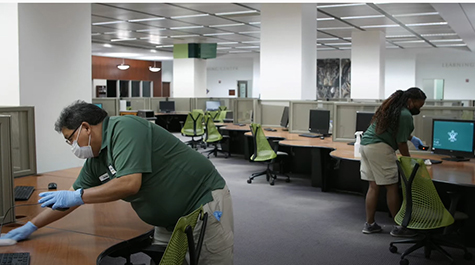W&M introduces new cleaning, disinfecting techniques to combat COVID-19
As William & Mary begins welcoming students back to campus, the university is implementing enhanced cleaning and disinfection protocols to reduce the likelihood of the spread of infection from COVID-19.
The university’s facilities management will be cleaning and disinfecting high-contact areas in classrooms and public spaces on an accelerated schedule, consistent with CDC guidelines. The university has installed hand sanitation stations across campus, touch-free technology payments in dining halls, touchless temperature check kiosks and new signage to explain new health protocols.
“We realize that one of the biggest challenges is that there’s not a lot of time to adapt,” said Robert Morman, W&M’s director of building services. “You arrive on campus and you’ve got to quickly fit yourself into the new way of doing things. We’ve been preparing all summer for this new normal, but for many this will be a major adjustment.”
One of the most immediate changes the campus community will notice is the reassignment and relocation of facilities staff, Morman explained.
“In some places where people have seen us in the past, we simply won’t be there this fall,” he said.
To promote health and help prevent the spread of infection, employees and students are responsible for maintaining their personal work and living spaces, using materials provided by the university. Students will be responsible for cleaning class desk space before and after use.
“That’s the shared responsibility factor, because there are simply not enough resources to clean and disinfect every space on campus,” Morman said. “We are asking people in the community to be responsible for the spaces where they live and work. That will free up our staff to focus on the shared and high circulation spaces like hallways, lobbies, elevators, stairs and restrooms.”
Keeping surfaces safe under pandemic conditions is no simple task. The process is two-fold, Morman said. There is cleaning and then there is disinfecting. Both have to occur in tandem. Roughly half of the custodial staff has been assigned to cleaning and the other to disinfecting. They have all been assigned to certain areas on campus that they will monitor throughout the day, wiping down and disinfecting frequently touched surfaces.
The university has purchased electrostatic sprayers to disinfect large areas and has introduced a series of new chemicals – Vital Oxide, Virex Tb and Spectra 410 – that are registered by the EPA as effective against SARS-CoV-2, the virus that causes the disease COVID-19.
As for staff, Morman says custodial workers are required to wear personal protective equipment — or PPE — at all times. Staff are provided gloves, masks and face shields and have undergone mandatory health and safety training. All frontline custodial staff have been tested for COVID-19, along with all the post office employees, whom he also manages.
“We’ve built in layer upon layer of protection here for the staff that are out there working to keep this campus safe and clean,” Morman said. “The most important part of my job is making sure my staff go home at the end of the day as safe and healthy as when they came to work. That’s why we have such robust protocols in place.”
A key part of the university’s efforts is a series of five mandatory training modules for all students and employees. The modules include an explanation of the Healthy Together Community Commitment, a tutorial on mask use and other requirements, a review of preventative hygiene — such as hand washing, sanitizer and the difference between cleaning and disinfecting spaces — and tips on how to appropriately intervene when someone is not following protocols.
“One thing that’s really vital for our community to know is that we are doing everything we can to keep the buildings safe, but once people step outside, it’s up to them to uphold the expectations of our community commitment,” Morman said. “This will be the most critical component of our ability to keep the campus open this fall. We all need to get on board and do the right things.”
 Skip to main content
Skip to main content

